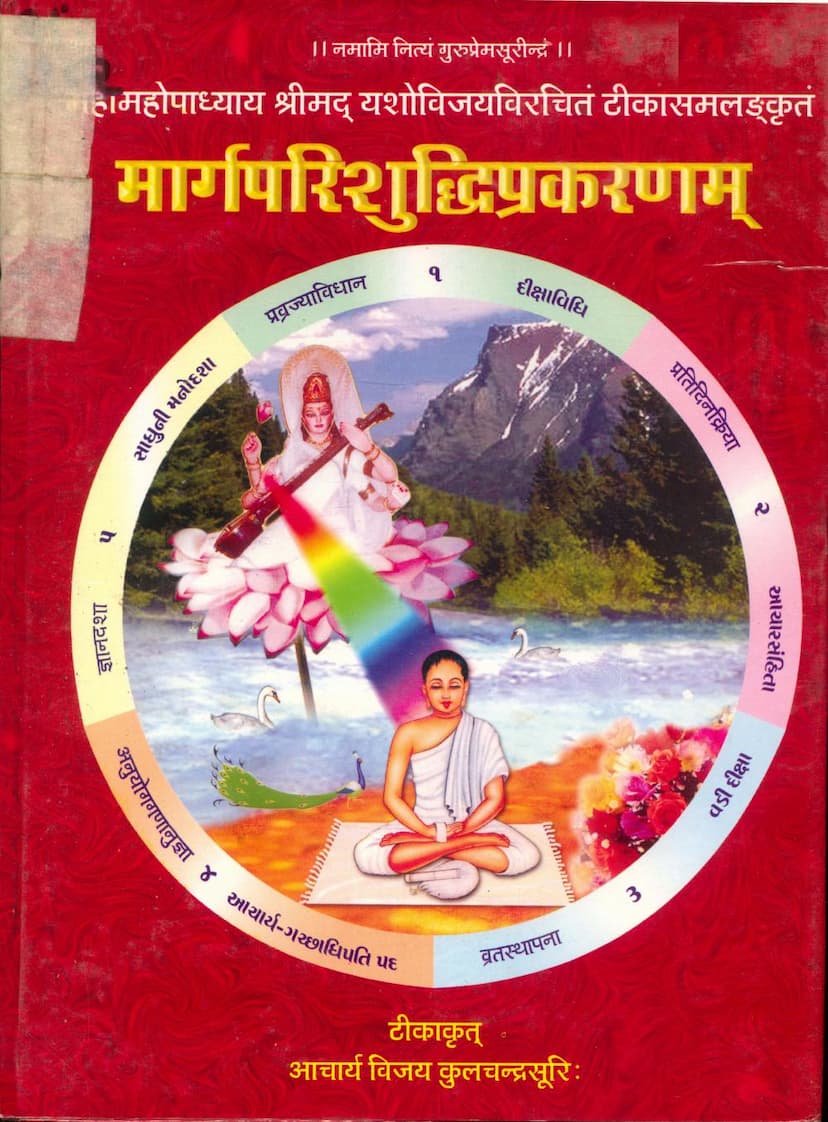Margparishuddhi Prakaranam
Added to library: September 2, 2025

Summary
Here's a comprehensive summary of the Jain text "Margparishuddhi Prakaranam" by Acharya Vijay Kulchandrasuri, with a commentary by Mahamahopadhyaya Yashovijayji:
Title: Margparishuddhi Prakaranam (The Clarification of the Path) Author of Original Work: Mahamahopadhyaya Yashovijayji Commentary and Publication: Acharya Vijay Kulchandrasuri Publisher: Shri Bhidbhanjan Parshwanath Jain Sangh, Bhiwandi (Maharashtra)
Overall Purpose and Content:
"Margparishuddhi Prakaranam" is a profound work that meticulously outlines and clarifies the path to liberation (moksha) according to Jain philosophy. It is based on the highly revered "Panchavastuk" (The Five Entities/Essences) composed by Acharya Haribhadrasuri. Mahamahopadhyaya Yashovijayji's commentary is presented with great skill, making the complex teachings accessible. Acharya Vijay Kulchandrasuri further explains the significance and the comprehensive nature of this work. The book serves as a guide for spiritual seekers, detailing the essential practices and philosophical underpinnings required for spiritual progress.
Key Themes and Structure:
The text systematically elaborates on the five main topics derived from the "Panchavastuk":
-
Pravrajya Vidhi (The Ritual of Renunciation/Initiation): This section delves into the process and qualifications for taking monastic vows. It covers the virtues of the one who renounces, the suitability for initiation based on age and other factors, and addresses various philosophical viewpoints and counterarguments on the topic. It also details the rituals involved, such as the offering of the rajoharan (a broom made of wool used by monks/nuns), the significance of shaving the head (mundan vidhi), and other essential rites following initiation.
-
Pratidin Kriya (Daily Practices): This part focuses on the daily routines and observances expected of a monk or nun. It discusses the significance of following the scriptures in daily actions and the establishment of virtues through practice. It outlines the process of Vratasthapana (establishment in vows), the responsibilities of the one being established, the perfection of the great vows (Mahavrata), the examination of the trainee (Shaiksha Pariksha), and the methods of upholding these vows.
-
Anuyog Gan Anugna Vidhi (The Procedure of Receiving Permission for Study and Instruction): This section addresses the process of gaining permission for studying Jain scriptures and teachings. It discusses who is qualified to receive instruction, the proper method of receiving it, the importance of understanding the subject matter, and the fruits of right understanding. It also touches upon various aspects of scriptural study, including the praise of sacred texts, the importance of correct interpretation, and the distinction between different types of stotras (hymns of praise), particularly dravya-stotra (praise of the external form) and bhava-stotra (praise of the internal qualities). It also discusses the validity of Vedic texts and their reconciliation with Jain principles, emphasizing the superior merit of bhava-stotra.
-
Gana Anugna Vidhi (The Procedure of Authorizing the Sangha/Community Leaders): This part focuses on the authorization of community leaders, discussing the qualifications for becoming an Acharya (spiritual teacher) or a head of a monastic community (Ganadhar). It stresses the importance of appointing worthy individuals to positions of authority, highlighting the grave consequences of appointing unsuitable persons. It outlines the process of granting authority within the monastic order and the responsibilities associated with leadership.
-
Samlekhana (Religious Austerity and Fasting unto Death): While the original "Panchavastuk" includes Samlekhana as the fifth topic, in the context of the present era (Kaliyuga), where the intellect and physical strength are considered diminished, the author provides guidance on cultivating the necessary disposition and discipline for potential samlekhana. This section emphasizes self-knowledge and adherence to the scriptural paths to liberation, guided by the grace of the guru.
Commentary by Acharya Vijay Kulchandrasuri:
Acharya Vijay Kulchandrasuri's commentary is highly praised for its clarity and depth. He describes the original work as an invaluable guide to the path of moksha, skillfully summarizing the entire path of liberation in its initial sixteen verses. He notes that the text addresses contentious points in a concise yet precise manner. The commentary highlights the author's mastery of logic and philosophy. Acharya Kulchandrasuri explains his motivation for writing the commentary, initially pausing when he learned that another scholar was working on it, and resuming the task after realizing the need and the other scholar's inability to complete it due to various engagements.
Key Principles and Teachings:
- The Path to Liberation: The book underscores that the ultimate goal is liberation, and the path is multifaceted, requiring adherence to vows, daily practices, scriptural study, and proper spiritual leadership.
- The Importance of the Guru: The text consistently emphasizes the indispensable role of the guru in guiding the disciple through the spiritual journey.
- Holistic Approach: It presents a comprehensive view of spiritual practice, encompassing external rituals, internal contemplation, ethical conduct, and philosophical understanding.
- Distinction between Nayas (Perspectives): The commentary clarifies the nuanced Jain philosophical approach, distinguishing between Nishchaya Naya (ultimate reality) and Vyavahar Naya (conventional reality) and how both are essential for complete understanding.
- Ethical Conduct: A significant portion of the text is dedicated to outlining ethical principles, the consequences of actions, and the correct way to practice non-violence (Ahimsa) in its various forms.
- Scriptural Authority: The work firmly grounds its teachings in the scriptures, constantly referencing and interpreting them to provide clarity.
- The Purity of Intention: Beyond mere outward actions, the text stresses the importance of pure intentions and right understanding in all spiritual endeavors.
Significance:
"Margparishuddhi Prakaranam," as commented upon by Acharya Vijay Kulchandrasuri and authored by Mahamahopadhyaya Yashovijayji, is considered a foundational text for spiritual seekers within the Jain tradition. It provides a systematic and authoritative exposition of the path to spiritual purity and ultimate liberation, making it a valuable resource for both scholars and practitioners. The publication by Shri Bhidbhanjan Parshwanath Jain Sangh ensures its accessibility for wider study and practice.